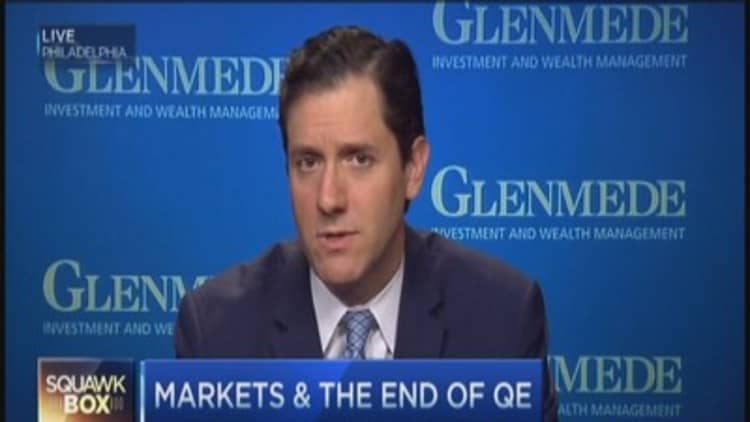
WASHINGTON — It's the end of Q.E., and financial markets feel fine.
The Federal Reserve is widely expected to announce on Wednesday the end of its latest bond-buying program, known as quantitative easing, or Q.E. Fed officials say the purchases served to strengthen job growth, and the economic recovery no longer needs quite so much of the central bank's support.
Investors panicked and markets convulsed in the summer of 2013 when the Fed first hinted that this day was coming. But the Fed has since avoided all the drama by loudly announcing a schedule for the retreat and then adhering to it with absolute fidelity.
Read MoreHow25 percent of global GDP could be washed away
"The exit protocol has been so well documented for the last nine months that the market has fully priced it in," said Barbara J. Cummings, who manages a $3.5 billion fixed-income portfolio for the Boston Private Bank & Trust Company. "I don't anticipate any movement. I feel as though this is one meeting where they almost don't need to hold it because they have made it perfectly clear."
The decision, expected at the end of a two-day meeting of the Fed's policy-making committee, would cap a six-year period during which the central bank has expanded its holdings of Treasury and mortgage-backed securities to almost $4.5 trillion, from less than $1 trillion in mid-2008.
More from The New York Times:
Lawsuit Contends Consultant Misled Detroit Pension Plan
More Renters, Less Risk for Wall St.
Apple Pay Runs Afoul of MCX, a Group With a Rival Product
The Fed has paused its stimulus campaign several times since the financial crisis only to conclude that the economy needed more help. But officials say they are confident that the current level of stimulus is sufficient. Through September, employers added an average of 227,000 jobs a month, and the unemployment rate has fallen faster than expected, to 5.9 percent.
The Fed next plans to enter a holding pattern, a final phase in which it will maintain the size of the bond portfolio and keep short-term interest rates near zero, until officials decide that the economy no longer needs the help.
For more than a year, a majority of Fed officials have pointed steadily to the middle of 2015 as the most likely time for a rate increase. Some officials want the Fed to explain more clearly how it will decide when the time has come. Others, however, are concerned that changes in the statement will be interpreted prematurely as evidence that the Fed is pulling back.
Read MoreAs housing marketstruggles, the rich are refinancing
Carl R. Tannenbaum, chief economist at Northern Trust, said he expected the Fed to wait at least until its next meeting, in December, before providing more guidance about its plans for interest rates. "I'll go way out on a limb and suggest that there will be no outward change in monetary policy," he said.
Mr. Tannenbaum added that he hoped the Fed would emulate the clarity of its retreat from bond-buying as it moved toward raising interest rates. "I do think this has been a success story," he said. "I'm hoping that when the time comes to raise interest rates that they'll do an equally clear job of foreshadowing that."

Just a few months ago, a growing number of Fed officials were expressing concern that the central bank might need to start raising rates in the spring. But inflation has remained persistently sluggish. Most Fed officials predicted in September that in the next two years, inflation would not reach the 2 percent annual pace the Fed regards as most beneficial for the economy. John Williams, president of the Federal Reserve Bank of San Francisco, said this month that he saw a greater chance that the first increase would be delayed.
Asset prices continue to reflect even greater pessimism among many investors. This is partly a distortion caused by the high demand for Treasuries as worried investors move money from Europe to the United States. But some analysts say it also reflects a widespread view among investors that the Fed is once again overestimating the economic recovery.Torsten Slok, chief international economist at Deutsche Bank Securities, said he did not expect much of a reaction from financial markets even if the Fed suggested on Wednesday that its economic outlook had improved.
Read MoreMarkets could shrug off Fed if it sounds dovish
"If the Fed turns hawkish tomorrow the market will likely think that Fed hikes are premature because there are still no signs of inflation, and this would also push yields down," Mr. Slok wrote in a note to clients on Tuesday. "It will take more time for the market to shake off the bearish narrative that has been so widespread among fixed income investors over the past six years."
Ms. Cummings said it was more likely that the Fed was wrong.
"I do think they're overly optimistic," she said. "The market and the Fed are definitely saying two different things. And the market is right. It usually is."

